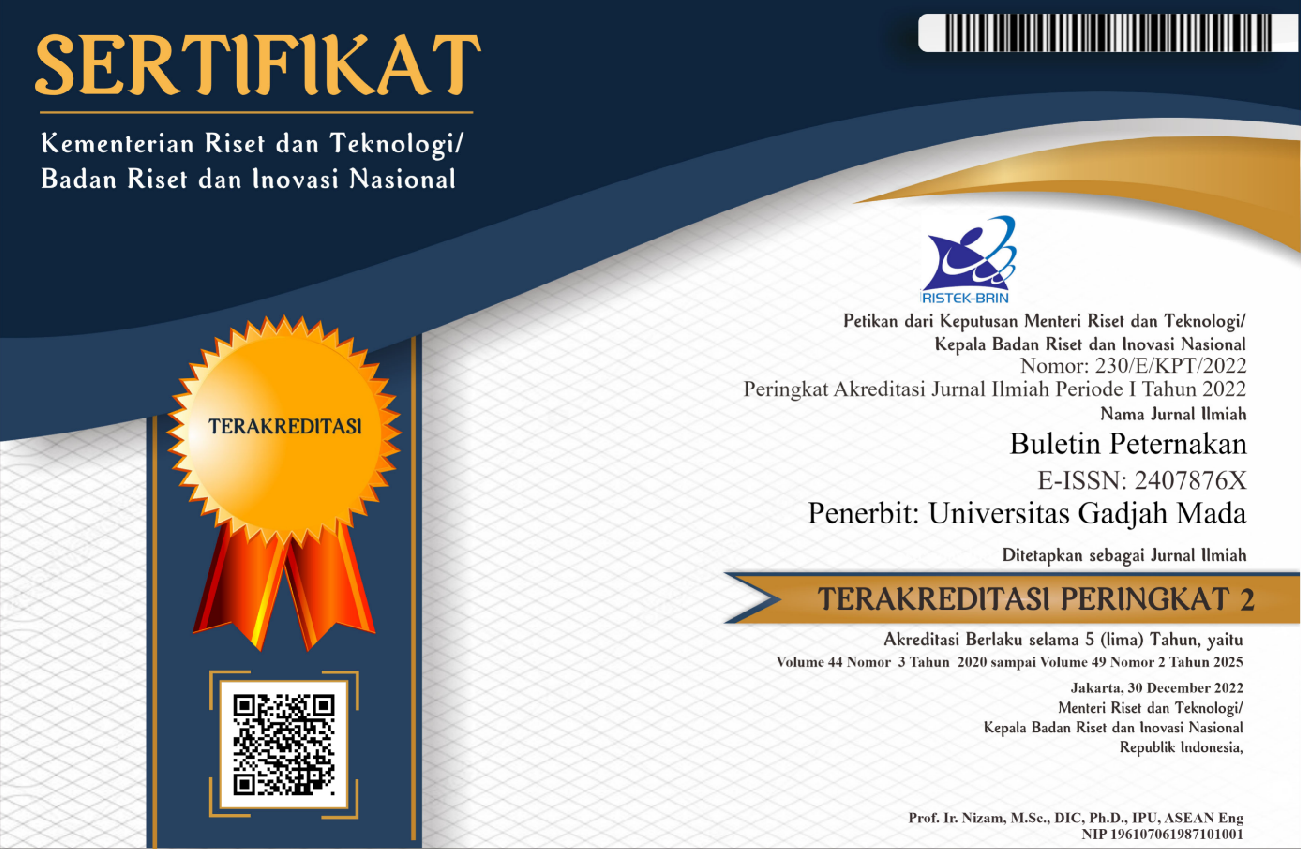KAJIAN IN VITRO SUBTITUSI KONSENTRAT DENGAN PENGGUNAAN LIMBAH PERKEBUNAN SINGKONG YANG DISUPLEMENTASI KOBALT (Co) DAN SENG (Zn) DALAM RANSUM DOMBA
Iman Hernaman(1*), Atun Budiman(2), Siti Nurachman(3), Kundrat Hidrajat(4)
(1)
(2)
(3)
(4)
(*) Corresponding Author
Abstract
This research was aimed to investigate the effect of concentrate substitution with cassava plantation waste supplemented with cobalt and zinc in sheep ration. In vitro study was used in this experiment. Collected data were analyzed by Duncan’s test from Completely Randomized Design with four treatments and four replications. The experiment rations were R1 = 50% native grass + 50% concentrate, R2 = 50% native grass + 50% concentrate + 5 ppm cobalt + 30 ppm zinc, R3 = 50% native grass + 50% cassava plantation waste, R4 = 50% native grass + 50% cassava plantation waste + 5 ppm cobalt + 30 ppm zinc. The results showed that utilization of concentrate increased volatile fatty acid and N-NH3 concentration, and digestibility of dry and organic matter compared with cassava plantation waste. Volatile fatty acid and N-NH3 in sheep ration containing cassava plantation waste were still in normal range with dry and organic matter digestibility were up to 50%, but supplementation of cobalt and zinc had the same effect (P>0.05). It is concluded that cassava plantation waste can be used as sheep feed, but did not substitute concentrate. Supplementation of cobalt and zinc was not effective to improve fermentability and digestibility of cassava plantation waste.
(Key words: Cassava plantation waste, Digestibility, In vitro, N-NH3, Sheep, Volatile fatty acid)
Full Text:
PDFReferences
AOAC. 2005. Official Methods of Analysis.18th edn. Association of Official Agricultural Chemists. Washington, DC.
Astuti, A., A. Agus, dan S. P. S. Budhi. 2009. Pengaruh penggunaan high quality feed supplement terhadap konsumsi dan kecernaan nutrien sapi perah awal laktasi. Buletin Peternakan 33: 81-87.
Bergen, W. G. 1977. Factors affecting growth yields of micro-organisms in the rumen. Trop. Anim. Prod. 4: 13-20.
Chaves, A. V., G. C. Waghorn, I. M. Brookes and D. Hedderley. 2002. Digestion kinetics of ryegrass. Proceedings of the New Zealand Society of Animal Production 62: 157-162.
Church, D. C. 1984. Livestock Feeds and Feeding. 2nd edn. O&B Books Inc. Corvallis, Oregon.
Despal. 2000. Kemampuan komposisi kimia dan kecernaan in vitro dalam mengestimasi kecernaan in vivo. Media Peternakan 23: 84-88.
Hau, D. K, M. Nenobais, J. Nulik, dan N. G. F. Katipana. 2005. Pengaruh probiotik terhadap kemampuan cerna mikroba rumen sapi Bali. Seminar Nasional Teknologi Peternakan dan Veteriner.
Hernaman, I. U. H. Tanuwiria, dan M. F. Wiyatna. 2005. Pengaruh Penggunaan Berbagai Tingkat Kulit Kopi dalam Ransum Penggemukan Sapi Potong terhadap Fermentabilitas Rumen dan Kecernaan In-Vitro. Bionatura 7: 46-50.
Hernaman, I. A. Budiman, S. Nurachma, dan K. Hidajat. 2010. Potensi Limbah Tanaman Singkong sebagai Pakan Ruminansia. Prosiding Seminar Nasional Peternakan Berkelanjutan ke-2: Sistem Produksi Berbasis Ekosistem Lokal, Fakultas Peternakan Universitas Padjadjaran Jatinangor 4 November 2010.
Indraningsih, R. Widiastuti, dan Y. Sani. 2012. Limbah Pertanian dan Perkebunan sebagai Pakan Ternak : Kendala dan Prospeknya. Lokakarya Nasional IPTEK dalam Pengendalian Penyakit, Strategi pada Ternak Ruminansia. Bogor.
Jianping, L. and T. Yinong. 2005. Use of cassava root meal and leaf silage for animal feeding in Yunnan Province of China. The use of cassava roots and leaves for on farm animal feeding. Editor R.H Howler. Proceeding of A Regional Workshop. Hue City. Vietnam.
Krisidayova, S., P. Sviatko, P. Siroka and D. Jalc. 2001. Effect of elevated cobalt intake on fermentative parameters and protozoan population in RUSITEC. Anim. Feed. Sci. Tech. 91: 223-232.
Prasojo, A. P. W., F. M. Suhartati, dan S. Rahayu. 2013. Pemanfaatan kulit singkong fermentasi menggunakan leuconostoc mesenteroides dalam pakan pengaruhnya terhadap n-nh3 dan VFA (in vitro). Jurnal Ilmiah Peternakan 1: 397-404.
Russell, J. B. and H. J. Stobel. 1993. Microbial energetics. In: Quantitative Aspects of Ruminant Digestion and Metabolism. J. M. Forbes. and J. France (eds). CAB International. Wallingford, UK.
Steel, R. G. D. and J. H. Torrie. 1993. Prinsip dan Prosedur Statistika. PT. Gramedia Pustaka Utama.
Sugoro, I. I. Gobel, dan N. Lelananingtyas. 2005. Pengaruh probiotik khamir terhadap fermentasi dalam cairan rumen secara in vitro. Seminar Nasional Teknologi Peternakan dan Veteriner. Bogor 12-15 September 2005.
Sutardi, T. 1978. Ikhtisar Ruminologi. Bahan Kursus Peternakan Sapi Perah. Kayu Ambon. Dirjen Peternakan-FAO.
Sutardi, T. 2001. Revitalisasi peternakan sapi perah melalui penggunaan ransum berbasis limbah perkebunan dan suplementasi mineral organik. Laporan akhir RUT VIII 1. Kantor Kementrian Negara Riset dan Teknologi dan LIPI.
Tilley, J. M. A. and R. A Terry. 1963. A two stage technique for the in vitro digestion of forage crops. J. British. Grassl. Soc. 18: 104-111.
Tortuero, F., J. Rioperez, C. Cosin, J. Barrera and M. L. Rodriguez. 1994. Effects of dietary fiber sources on volatile fatty acid production, intestinal microflora and mineral balance in rabbits. Anim. Feed Sci. Technol. 48: 1-14.
Tweyongyere, R. and Katongole. 2002. Cyanogenic potential of cassava peels and their detoxification for utilization as livestock feed. Vet. Hum. Toxicol. 44: 366-369.
Usman, Y. 2013. Pemberian pakan serat sisa tanaman pertanian (jerami kacang tanah, jerami jagung, pucuk tebu) terhadap evolusi pH, N-NH3 dan VFA di dalam rumen sapi. Agripet. 13: 53-58.
Article Metrics
Refbacks
- There are currently no refbacks.
Buletin Peternakan (Bulletin of Animal Science) Indexed by:

This work is licensed under a Creative Commons Attribution-ShareAlike 4.0 International License.









